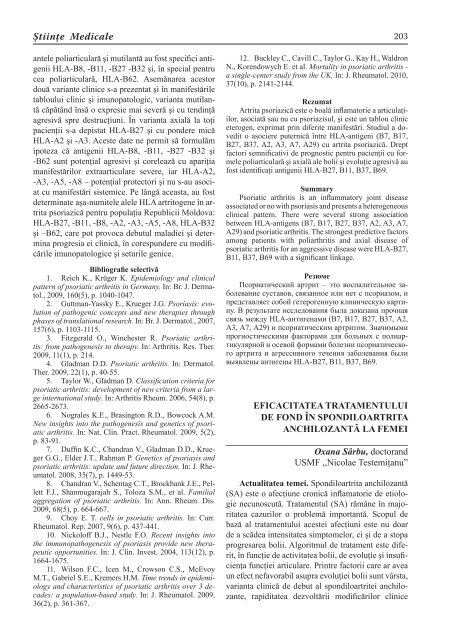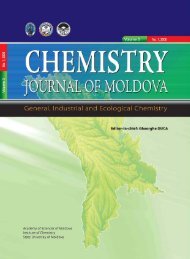stiinte med 3 2011.indd - Academia de ÅtiinÅ£e a Moldovei
stiinte med 3 2011.indd - Academia de ÅtiinÅ£e a Moldovei
stiinte med 3 2011.indd - Academia de ÅtiinÅ£e a Moldovei
Create successful ePaper yourself
Turn your PDF publications into a flip-book with our unique Google optimized e-Paper software.
Ştiinţe Medicale<br />
antele poliarticulară şi mutilantă au fost specifici antigenii<br />
HLA-B8, -B11, -B27 -B32 şi, în special pentru<br />
cea poliarticulară, HLA-B62. Asemănarea acestor<br />
două variante clinice s-a prezentat şi în manifestările<br />
tabloului clinic şi imunopatologic, varianta mutilantă<br />
căpătând însă o expresie mai severă şi cu tendinţă<br />
agresivă spre <strong>de</strong>strucţiuni. În varianta axială la toţi<br />
pacienţii s-a <strong>de</strong>pistat HLA-B27 şi cu pon<strong>de</strong>re mică<br />
HLA-A2 şi -A3. Aceste date ne permit să formulăm<br />
ipoteza că antigenii HLA-B8, -B11, -B27 -B32 şi<br />
-B62 sunt potenţial agresivi şi corelează cu apariţia<br />
manifestărilor extraarticulare severe, iar HLA-A2,<br />
-A3, -A5, -A8 – potenţial protectori şi nu s-au asociat<br />
cu manifestări sistemice. Pe lângă aceasta, au fost<br />
<strong>de</strong>terminate aşa-numitele alele HLA artritogene în artrita<br />
psoriazică pentru populaţia Republicii Moldova:<br />
HLA-B27, -B11, -B8, -A2, -A3, -A5, -A8, HLA-B32<br />
şi –B62, care pot provoca <strong>de</strong>butul maladiei şi <strong>de</strong>termina<br />
progresia ei clinică, în corespun<strong>de</strong>re cu modificările<br />
imunopatologice şi seturile genice.<br />
Bibliografie selectivă<br />
1. Reich K., Krüger K. Epi<strong>de</strong>miology and clinical<br />
pattern of psoriatic arthritis in Germany. In: Br. J. Dermatol.,<br />
2009, 160(5), p. 1040-1047.<br />
2. Guttman-Yassky E., Krueger J.G. Psoriasis: evolution<br />
of pathogenic concepts and new therapies through<br />
phases of translational research. In: Br. J. Dermatol., 2007,<br />
157(6), p. 1103-1115.<br />
3. Fitzgerald O., Winchester R. Psoriatic arthritis:<br />
from pathogenesis to therapy. In: Arthritis. Res. Ther.<br />
2009, 11(1), p. 214.<br />
4. Gladman D.D. Psoriatic arthritis. In: Dermatol.<br />
Ther. 2009, 22(1), p. 40-55.<br />
5. Taylor W., Gladman D. Classifi cation criteria for<br />
psoriatic arthritis: <strong>de</strong>velopment of new criteria from a large<br />
international study. In: Arthritis Rheum. 2006, 54(8), p.<br />
2665-2673.<br />
6. Nograles K.E., Brasington R.D., Bowcock A.M.<br />
New insights into the pathogenesis and genetics of psoriatic<br />
arthritis. In: Nat. Clin. Pract. Rheumatol. 2009, 5(2),<br />
p. 83-91.<br />
7. Duffin K.C., Chandran V., Gladman D.D., Krueger<br />
G.G., El<strong>de</strong>r J.T., Rahman P. Genetics of psoriasis and<br />
psoriatic arthritis: update and future direction. In: J. Rheumatol.<br />
2008, 35(7), p. 1449-53.<br />
8. Chandran V., Schentag C.T., Brockbank J.E., Pellett<br />
F.J., Shanmugarajah S., Toloza S.M., et al. Familial<br />
aggregation of psoriatic arthritis. In: Ann. Rheum. Dis.<br />
2009, 68(5), p. 664-667.<br />
9. Choy E. T. cells in psoriatic arthritis. In: Curr.<br />
Rheumatol. Rep. 2007, 9(6), p. 437-441.<br />
10. Nickoloff B.J., Nestle F.O. Recent insights into<br />
the immunopathogenesis of psoriasis provi<strong>de</strong> new therapeutic<br />
opportunities. In: J. Clin. Invest. 2004, 113(12), p.<br />
1664-1675.<br />
11. Wilson F.C., Icen M., Crowson C.S., McEvoy<br />
M.T., Gabriel S.E., Kremers H.M. Time trends in epi<strong>de</strong>miology<br />
and characteristics of psoriatic arthritis over 3 <strong>de</strong>ca<strong>de</strong>s:<br />
a population-based study. In: J. Rheumatol. 2009,<br />
36(2), p. 361-367.<br />
203<br />
12. Buckley C., Cavill C., Taylor G., Kay H., Waldron<br />
N., Korendowych E. et al. Mortality in psoriatic arthritis -<br />
a single-center study from the UK. In: J. Rheumatol. 2010,<br />
37(10), p. 2141-2144.<br />
Rezumat<br />
Artrita psoriazică este o boală inflamatorie a articulaţiilor,<br />
asociată sau nu cu psoriazisul, şi este un tablou clinic<br />
eterogen, exprimat prin diferite manifestări. Studiul a dovedit<br />
o asociere puternică între HLA-antigeni (B7, B17,<br />
B27, B37, A2, A3, A7, A29) cu artrita psoriazică. Drept<br />
factori semnificativi <strong>de</strong> prognostic pentru pacienţii cu formele<br />
poliarticulară şi axială ale bolii şi evoluţie agresivă au<br />
fost i<strong>de</strong>ntificaţi antigenii HLA-B27, B11, B37, B69.<br />
Summary<br />
Psoriatic arthritis is an inflammatory joint disease<br />
associated or no with psoriasis and presents a heterogeneous<br />
clinical pattern. There were several strong association<br />
between HLA-antigens (B7, B17, B27, B37, A2, A3, A7,<br />
A29) and psoriatic arthritis. The strongest predictive factors<br />
among patients with poliarthritis and axial disease of<br />
psoriatic arthritis for an aggressive disease were HLA-B27,<br />
B11, B37, B69 with a significant linkage.<br />
Резюме<br />
Псориатический артрит – это воспалительное заболевание<br />
суставов, связанное или нет с псориазом, и<br />
представляет собой гетерогенную клиническую картину.<br />
В результате исследования была доказана прочная<br />
связь между HLA-антигенами (B7, B17, B27, B37, А2,<br />
А3, А7, А29) и псориатическим артритом. Значимыми<br />
прогностическими факторами для больных с полиартикулярной<br />
и осевой формами болезни псориатического<br />
артрита и агрессивного течения заболевания были<br />
выявлены антигены HLA-B27, B11, B37, B69.<br />
EFICACITATEA TRATAMENTULUI<br />
DE FOND ÎN SPONDILOARTRITA<br />
ANCHILOZANTĂ LA FEMEI<br />
_______________________________________<br />
Oxana Sârbu, doctorand<br />
USMF ,,Nicolae Testemiţanu”<br />
Actualitatea temei. Spondiloartrita anchilozantă<br />
(SA) este o afecţiune cronică inflamatorie <strong>de</strong> etiologie<br />
necunoscută. Tratamentul (SA) rămâne în majoritatea<br />
cazurilor o problemă importantă. Scopul <strong>de</strong><br />
bază al tratamentului acestei afecţiuni este nu doar<br />
<strong>de</strong> a scă<strong>de</strong>a intensitatea simptomelor, ci şi <strong>de</strong> a stopa<br />
progresarea bolii. Algoritmul <strong>de</strong> tratament este diferit,<br />
în funcţie <strong>de</strong> activitatea bolii, <strong>de</strong> evoluţie şi insuficienţa<br />
funcţiei articulare. Printre factorii care ar avea<br />
un efect nefavorabil asupra evoluţiei bolii sunt vârsta,<br />
varianta clinică <strong>de</strong> <strong>de</strong>but al spondiloartritei anchilozante,<br />
rapiditatea <strong>de</strong>zvoltării modificărilor clinice

















